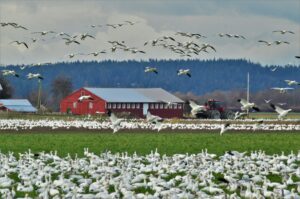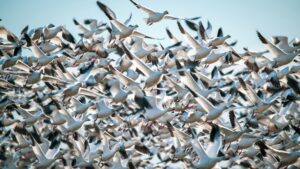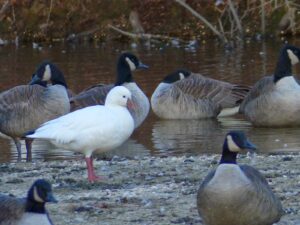Snow Geese – look carefully at every flock. There may be more than Snow Geese in each one …..

Snow Geese are migrating and you might see and hear flocks overhead for at least another week. Out here in the midwest, they land to forage in our huge, harvested agricultural fields and to rest on our lakes. We do not often have them here on our small lake, but we do have them on the large lake that is close-by and they are often in the fields all around us. Their flocks can be huge – and amazing to watch in the sky. Each flock is formed of many ‘V’s” and slanted lines, and they cross and recross all over their area of sky. They are often so high, they are hard to see, but you can always hear them. Geese are chatty as they fly.

If a flock is on your lake, in any of your fields, or flying overhead, use your binoculars or scope and try to look at as many individual birds as you can. Look for a goose that looks exactly like a Snow Goose but is only about half as big. When on the ground, one or more can be anywhere in the flock, but if there are more than one, they tend to stay together. When they are flying in their somewhat ragged and uneven ‘V’s’ or in slanted lines, look for these smaller birds at the ends of the ‘V’s’ or lines. When I first saw these birds at Middle Creek Wildlife Refuge in Pennsylvania, I thought they were juvenile Snow Geese – they are not. They are Ross’s Geese.

Here is a photo of a Ross’s Goose taken at Marshall’s Pond, Tom’s River, NJ. Normally, they are not alone and with Canada Geese, but Larry caught this one and what a wonderful photo for comparison. The Ross’s Goose is noticeably smaller. A Snow Goose is larger than the Ross’s Goose, but smaller than the Canada Goose.
Ross’s Goose: 23-25 inches tall and weighs 2.5-3.5 pounds
Snow Goose: 27-32 inches tall and weighs 4-6.25 pounds
Canada Goose: 30-40 inches tall and weighs 6.25-18 pounds*
If you look closely at a flock of Snow Geese, you will see two color variations called morphs. One is all white with black wing-tips – when the wings are folded, these dark wing-tips are at the tail. The other is dark blue with streaks of white here and there, and often more white on the head and neck. In my observations, there are always more white morphs than blue morphs in a flock, but your experience could be different. Ross’s Goose has the same two morphs – an all white one and a blue one. But the blue morphs are quire rare in comparison to the proportion of blue morphs in Snow Geese.
Besides the fact the Snow Goose is noticeably larger than Ross’s Goose, another way to tell them apart is to look at their heads and necks. Snow Geese often have rather dirty faces – white, streaked with brown. They dig down into soil to eat roots and tubers and this stains their heads and necks. Ross’s Geese tend to eat the plants, not the roots and so their faces are white – no dirt.
There are approximately 1.7 million Ross’s Geese and about 16 million Snow Geese*.
*The statistics for this blog were obtained from:
Partners in Flight
allaboutbirds.org
National Audubon Society
All three of their websites will have more information on both birds.

